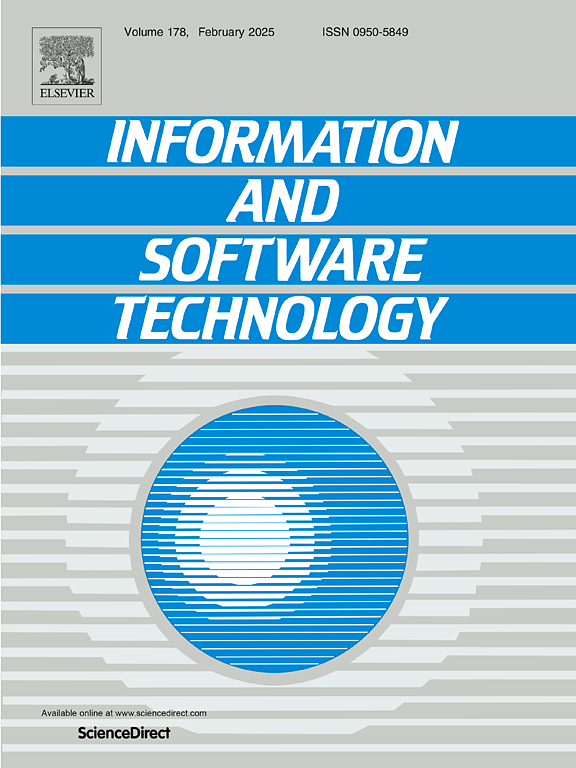A taxonomy of microservice integration techniques
IF 4.3
2区 计算机科学
Q2 COMPUTER SCIENCE, INFORMATION SYSTEMS
引用次数: 0
Abstract
Context:
Microservices have become an important architectural style for building robust and scalable software systems. A system’s functionality is split into independent units, the microservices, that communicate over a network and can be deployed independently. The shift of complexity into the integration layer necessitates enhanced collaboration among stakeholders, stressing the importance of effective communication.
Objective:
We aim to streamline communication between stakeholders in microservice-based projects by constructing a framework for enhanced clarity, a taxonomy, by answering our research question: “How can microservice integration techniques be classified?”
Method:
We conducted a thematic analysis of literature and six expert interviews to identify microservice integration techniques and construct a taxonomy.
Results:
The results of this study are (i) a taxonomy for microservice integration techniques consisting of five main and ten refined categories, (ii) the classification of 121 found integration techniques, (iii) an illustration of the taxonomy usage based on three selected techniques to demonstrate the procedure in case of classification ambiguity, (iv) a comparison of data gathered from literature with the interviews, and (v) comprehensive supplementary materials.
Conclusion:
The taxonomy offers a structured framework to classify microservice integration techniques and enhances the understanding of the diverse landscape of microservice integration techniques, including organizational ones that are often overlooked. Practitioners can discover integration techniques through the taxonomy and apply them with guidance provided in the supplementary materials.

微服务集成技术的分类
上下文:微服务已经成为构建健壮和可伸缩软件系统的重要架构风格。系统的功能被分成独立的单元,即微服务,它们通过网络进行通信,并且可以独立部署。复杂性向集成层的转变需要加强涉众之间的协作,强调有效沟通的重要性。目标:我们的目标是通过构建一个框架来简化基于微服务的项目中利益相关者之间的沟通,通过回答我们的研究问题:“如何对微服务集成技术进行分类?”方法:我们进行了专题文献分析和六次专家访谈,以确定微服务集成技术并构建分类。结果:本研究的结果是:(i)微服务集成技术的分类法,包括5个主要类别和10个细化类别,(ii) 121个已发现的集成技术的分类,(iii)基于3种选定技术的分类法使用说明,以演示分类模糊情况下的程序,(iv)从文献中收集的数据与访谈的比较,以及(v)综合补充材料。结论:该分类法提供了一个结构化的框架来对微服务集成技术进行分类,并增强了对微服务集成技术多样性的理解,包括经常被忽视的组织集成技术。从业者可以通过分类法发现集成技术,并在补充材料中提供的指导下应用它们。
本文章由计算机程序翻译,如有差异,请以英文原文为准。
求助全文
约1分钟内获得全文
求助全文
来源期刊

Information and Software Technology
工程技术-计算机:软件工程
CiteScore
9.10
自引率
7.70%
发文量
164
审稿时长
9.6 weeks
期刊介绍:
Information and Software Technology is the international archival journal focusing on research and experience that contributes to the improvement of software development practices. The journal''s scope includes methods and techniques to better engineer software and manage its development. Articles submitted for review should have a clear component of software engineering or address ways to improve the engineering and management of software development. Areas covered by the journal include:
• Software management, quality and metrics,
• Software processes,
• Software architecture, modelling, specification, design and programming
• Functional and non-functional software requirements
• Software testing and verification & validation
• Empirical studies of all aspects of engineering and managing software development
Short Communications is a new section dedicated to short papers addressing new ideas, controversial opinions, "Negative" results and much more. Read the Guide for authors for more information.
The journal encourages and welcomes submissions of systematic literature studies (reviews and maps) within the scope of the journal. Information and Software Technology is the premiere outlet for systematic literature studies in software engineering.
 求助内容:
求助内容: 应助结果提醒方式:
应助结果提醒方式:


